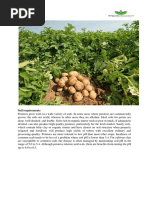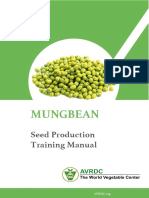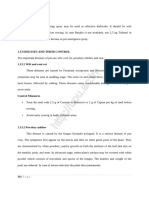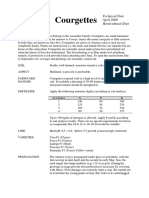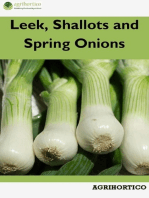Zantedeschia Manual: Scientific Name-Albomaculata Jucanda Family-Araceae Origin - South Africa
Zantedeschia Manual: Scientific Name-Albomaculata Jucanda Family-Araceae Origin - South Africa
Uploaded by
gridinsergiuCopyright:
Available Formats
Zantedeschia Manual: Scientific Name-Albomaculata Jucanda Family-Araceae Origin - South Africa
Zantedeschia Manual: Scientific Name-Albomaculata Jucanda Family-Araceae Origin - South Africa
Uploaded by
gridinsergiuOriginal Title
Copyright
Available Formats
Share this document
Did you find this document useful?
Is this content inappropriate?
Copyright:
Available Formats
Zantedeschia Manual: Scientific Name-Albomaculata Jucanda Family-Araceae Origin - South Africa
Zantedeschia Manual: Scientific Name-Albomaculata Jucanda Family-Araceae Origin - South Africa
Uploaded by
gridinsergiuCopyright:
Available Formats
Zantedeschia Manual
1. Introduction: The flower is popular in mono bouquets, mixed bouquets and as single flower in a vase and are also used in bridal bouquets Zantedeschia flowers are conspicuous for their shape, colour and exceptionally long vase life and can be transported 3 to 4 days without water. Zantedeschia is now in the Top 20 of cut flowers at Dutch flower auctions, with more than 70 million stems being sold per year.
Scientific Name-Albomaculata Jucanda Family- Araceae Origin- South Africa
2. Climate: Zantedeschia requires mild climate for its growth and development. a. Temperature: Best growth can be obtained under low temperature as plants develop less luxuriantly and become tougher. The required temperature range is in between 15o to 24oC (Day temperature 18o to 24oC, whereas night temperature 15o to 18oC). Lower temperature is preferred during flowering as it promotes more intense colour in the flowers, especially in pink and orange colour varieties. High temperature must be avoided after flowering, during tuber growth. Stage Day time Night time 19oC to 22oC 15o to 18oC 15o to 16oC Planting to 2.5-5cm 19oC to 22oC shoot After sprouting Flower colouring b. c. 18o to 24oC 18o to 24oC
Relative humidity: It can grow well under 60 to 75 per cent relative humidity. Light intensity: Light is a very important factor in the cultivation of Zantedeschia as it has influence on flower production per
bulb. It is also important for bright colour of flowers and height of the plant. Too many screens or low light intensity will decrease the flower production as well as paler flowers. The average light intensity is around 700 to 800 w/m2 3. Soil: The soil used for Zantedeschia cultivation should have good structure as well as drainage facility. Sandy loam or clay loam soil is most suitable for cultivation of zantedeschia. Soil should have pH in between 6.1 to 6.5 and EC should be less than 1. It is also important the soil should be free from primary fungus such as a Pythium or Rhizoctonia. Soil should get sterilized with H2O2. 4. Bed preparation and layout: For zantedeschia beds material required and its proportion is given below, Material Red/Poyta Soil Sand Vermicompost Clay soil 55% 15% 30% Silty loam soil 60% 10% 30%
Vermicompost and sand is added to enrich with organic matter and to improve the soil structure, respectively. At the time of bed preparation following basal dose is added, Single super phosphate: 2kg/100m2 Calcium nitrate: 3kg/100m2 Magnesium sulphate: 300g/100m2 All these material is mixed thoroughly. Beds of width of 1m and height of 35cm are prepared. The distance between two beds should be 30cm.
35cm
100cm
30 cm
5. Planting: In green house, planting can be done at any time of the year. Tubers above 12cm circumference are used for flowering. Always be sure that the tubers have undergone at least 10 to 11 weeks of dormancy.
Tuber treatment: tubers are dipped in solution of Copper Oxichloride (2 gm/lit) + Streptocyclin (0.1 gm/lit) for 5 minutes and dry in shade for a day. Then tubers are treated with GA3 (125 ppm) solution to break the dormancy, to avoid flower deformities and for uniform flowering. After drying tubers should be planted within 24 hours. Planting method: Generally planting is done at the depth of 10cm. Shallow planting is not recommended as the roots can start developing on the top of the tubers. The soil can be covered with wood shavings to ensure minimum fluctuation in temperature. Approximate planting densities for following sizes are; Tuber size 12 to 14cm 14 to 16cm 16 to 18cm 18 to 20cm 20 to 22cm Net per sq. m. 28 24 20 16 14 Gross per sq. m. 18 15.5 13 10.5 10.5 Spacing 20X15 20X18 20X22 20X30 20X32
6. Irrigation: The laterals are laid in between two rows of tubers. Drippers of 1.3lph discharge are kept at an interval of 20cm. Layout
Laterals Drippers at 20cm spacing Tubers
During the initial stage zantedeschia needs little quantity of water. Generally watering is done early in the morning. When leaves are unfolded and bed is covered with foliage then water is given by drip system. Daily water requirement is 3 to 5 lit/m2/day depending on climate & soil type. Avoid moisture fluctuation in bed because it favors root rot & other fungal diseases. Frequent weeding should be done by hand as roots emerge out from soil two weeks after planting. 7. Fertigation: Nutritional Composition for the Zantedeschia Main Elements Nutritional mmol/lit Requirement ppm (mg/lit) Trace Elements Nutritional mol/lit Requirement ppm (mg/lit)
NH4+ K Ca++ Mg++ NO3 SO4 P
-1.3 1.5 1.0 3.0 1.5 0.3 50.7 60 24 155 144 14.55
Fe++ Mn++ B Zn++ Cu++ Mo
25.0 2.0 30.0 3.0 1.0 0.5
1.4 0.11 0.33 0.20 0.063 0.05
Standard Fertilizer solution for the Zantedeschia: (Concentration 100 times in 1000 lit. water) A-Tank solution Sr. No. 1 2 Sr. No. 1 2 3 4 5 6 7 8 Nutrient Calcium Nitrate Fe-EDTA Nutrient Potassium Nitrate (KNO3) Mono Potassium Phosphate (0:52:34) Magnesium Sulphate (MgSO4) Borax Zinc Sulphate Copper Sulphate Manganese Sulphate Sodium molybdate 8.7Kg 4.0 Kg 24.6Kg 285 gm 86 gm 23 gm 34 gm 12 gm 35.4 Kg 1.0 Kg
B-Tank solution
Standard PH & E.C. of fertilizer solution should be 6.5 & 1 respectively
8. Harvesting and packing: Flowering generally starts 90 to 100 days after planting. The tuber that has stored for longer time will flower faster. The flowers are ready for harvesting when their stamens are visible. Generally flowers are harvested early in morning or in evening, when temperature is not too high. Harvesting can be done either by cutting or pulling. But pulling results in greater stem length and works more quickly than cutting and prevents splitting in the stems. While pulling stems are pulled at the base and not at the middle, this prevents stem from becoming weak. Avoid damage to
9.
10.
11.
12.
adventitious bud, so pull stem gently and carefully. Flowers are then brought to cold storage at 10oC. After harvesting, flowers are graded and kept in a preservative solution (Sodium hypochlorite 7-10ml/lit). This will reduce stem splitting and damage from post harvest diseases. Flower stem length is 30 to 70cm. Prepare bunches of 10 flowers. These flowers are kept in corrugated boxes of 80x30x12cm length. 40 to 50 Flowers are packed in one box. Boxes must have holes for aeration. Yield: Besides the variety and the size of the tubers flower production depends upon age of the plant material, its virus free state, applied preparation techniques, gibberline treatment, light intensity, humidity of soil and care taken during harvesting. Generally 4 to 5 flowers per tuber can be expected. Tuber harvesting: Before tuber harvesting irrigation is stopped for one month. During this period plants slowly become yellowish and finally become dry. Crop life cycle is of 5 to 6 months and crop senescence starts from six months onwards. After plant senescence begins (Visible with the onset of yellow and decaying leaves), lifting of the tubers can be done by hand digging. Proper care should be taken while digging as young tubers can get damaged. It is also important that not to harvest tubers prior to senescence. During senescence, tuberization (replication of new tubers) is completed and surface of the tubers becomes tougher. Tuber storage: Collected tubers are kept at 20oC with good air circulation. Tubers are spread over mesh in single layer for 25 to 30 days. During this period tubers will get dried and skin gets hardened. Further the temperature is reduced to 15oC and then finally 9oC with relative humidity at 75 to 80 per cent. In clod storage these can stored for 90 days with good air ventilation. Tubers can be used for next production cycle after 90 to 100 days of dormancy period. Diseases: the root system must be able to develop properly. If the root zone is water logged, there is greater risk of damage from Pythium, Rhizoctonia and Phytophthora. Since Erwinia is secondary disease that caused by these primary fungal diseases, they must be encountered. a. Pythium: often appears on certain spots and damage the root system of tubers. The consequence is that during warm weather, the parts of the plant above the ground start to curl up. Compare to other plants, affected plants shows slower growth. Control measures: Drenching with Aliette (2g/lit), Topsin-M (2g/lit), Benlate (2g/lit), Captaf (2g/lit) b. Rhizoctonia: appears on the border between air and ground. Once the first symptoms of drooping stems are observed, remove the plant carefully from the ground. If stems appear
slimmy or rotten above the tuber and in the ground, this indicates Rhizoctonia damage. Control measures: Use pathogen free planting material Apply Rhidomil or Benomil (2g./lit) as a soil drenching. c. Alternaria manifests itself above ground as a black spot on the leaf. This fungus primarily appears during damp periods. Control measures: Spray with Dithane-M45 (2.5g/lit) d. Viruses: Following viruses can infect zantedeschia. Cucumber mosaic virus (CMV) Dieffenbachia mosaic virus (DMV Tomato spotted wilt virus (TSWV) Potyvirus (Potato virus X) Control measures: Control vectors such as aphids, thrips and mites Infected plants must be uproot and destroy immediately. e. Erwinia spp: is the most important bacterial disease observed in call lily damaging the crop on large scale. The symptom of infection can vary from a stem coming loose from the plant to the total collapse of the plan, with foul odour at the bottom of the stem. It is important to find out causes of infection. The bacteria attack particularly when the plants are stressed. Causes of infection Damage due to primary fungus in the ground. Too much or too little irrigation. Too high EC content. Damaged due to herbicide. Badly ventilated poly house with high relative humidity. Control measures: Spray with Streptomycin (0.1g/lit) Drench with Copperoxicloride (5g/lit) 13. Insect-Pest: a. Aphids: Aphids are dangerous for spreading viruses and colonial aphids for destroying the plants. Symptoms: Shiny gloss on the plant with possible black fungus.
b. Mites: On the old, brown parts of the bulbs they can appear. When there are many, they also can damage or even completely take away the new shoot of the bulb. Symptoms: Soft brown part on the bulbs. With bare eye the mites are hard to detect. You need a microscope to be sure. c. Thrips: Mostly during flowering they appear in the flower. Sucking damage can appear in the flowers. Symptoms: 0,5 cm lighter circles with black points in the middle in the flowers.
PEST CONTROL IN ZANTEDESCHIA: Pests Aphids Suggested Chemicals Astra, Lanate (Methomyl) Rogor (Dimethoate) Endosulphon Neemazol Malathion Confidor (Imidacloprid) Pride (Acetamiprid) Dantop (Clothianidin) Actra (Thimethoxan) Pegasus (Diafenthiuron) Calnova + Calpaste Padan (Cartephydrochloride) Regent (Fipronil) Confidor (Imidacloprid) Nuvan (Dichlorvos) + Nuvacvon (Monocrotophos) Rogor (Dimethoate) Pride (Acetamiprid) Vertimec (Abamectin) Calnova + Calpaste Actra (Thimethoxan) Pure Water Spray Wettable Sulphur Kelthane (Dicofol) Concentration per lit. 1.5 gm 2 ml 2 ml 2 ml 2 ml 0.5 ml 0.4 gm 1gm 0.5gm 1.25gm 0.5ml + 2gm 1gm 1.5 ml 0.5 ml 1.5 ml + 2ml 2 ml 0.4 gm 0.4 ml 0.5ml + 2gm 0.5gm 1.5 gm 1.5 ml
Thrips
Mites
Vertimec (Abamectin) Magister (Fenazaquin) Omite (Propergite) Milbeknock (Milbemectin) Derisom (D) : Drench @ 30 - 40 ml/plant (S) : Soil application around plant
0.4 ml 1 ml 1ml 0.5ml 2ml
You might also like
- First Aid of Common Emergencies in Outdoor Activities100% (3)First Aid of Common Emergencies in Outdoor Activities6 pages
- WATERMELONS BEGINNER'S GROWER GUIDE -HARRYNo ratings yetWATERMELONS BEGINNER'S GROWER GUIDE -HARRY14 pages
- Importance: Tomatoes Are Very Healthy As They Are A Good Source ofNo ratings yetImportance: Tomatoes Are Very Healthy As They Are A Good Source of11 pages
- Production Technology of Marigold in IndiaNo ratings yetProduction Technology of Marigold in India6 pages
- 3.wilt Management Advisory in PomegranateNo ratings yet3.wilt Management Advisory in Pomegranate4 pages
- Lisianthus Eustoma Grandiflorum Lizzy PDFNo ratings yetLisianthus Eustoma Grandiflorum Lizzy PDF1 page
- Rhubarb, the Pie Plant: Growing Practices and Nutritional InformationFrom EverandRhubarb, the Pie Plant: Growing Practices and Nutritional InformationNo ratings yet
- HIV 1 & 2 Antibodies Screening Test, Serum Non-ReactiveNo ratings yetHIV 1 & 2 Antibodies Screening Test, Serum Non-Reactive4 pages
- Arctic Adventures Snorkeling Silfra GuideNo ratings yetArctic Adventures Snorkeling Silfra Guide9 pages
- The Sickle Cell Membrane: Tip of The IcebergNo ratings yetThe Sickle Cell Membrane: Tip of The Iceberg38 pages
- Plant Diseases Identification Using Image Processing (MATLAB)No ratings yetPlant Diseases Identification Using Image Processing (MATLAB)34 pages
- Alcamo's Laboratory Fundamentals of Microbiology: by Jeffrey C. PommervilleNo ratings yetAlcamo's Laboratory Fundamentals of Microbiology: by Jeffrey C. Pommerville2 pages
- Uploadsmybrochuresallianz 3H Cover BrochureNo ratings yetUploadsmybrochuresallianz 3H Cover Brochure11 pages
- Instant download Congenital Heart Disease in Pediatric and Adult Patients: Anesthetic and Perioperative Management Ali Dabbagh pdf all chapter100% (1)Instant download Congenital Heart Disease in Pediatric and Adult Patients: Anesthetic and Perioperative Management Ali Dabbagh pdf all chapter50 pages
- 3 Top Acne Skin Care Tips For A Healthier SkinNo ratings yet3 Top Acne Skin Care Tips For A Healthier Skin3 pages
- Alternative and Herbal Livestock Health Sourcebook100% (2)Alternative and Herbal Livestock Health Sourcebook164 pages
- ACT. A Guide To The Development of Childrens Palliative Care ServicesNo ratings yetACT. A Guide To The Development of Childrens Palliative Care Services38 pages
- First Aid of Common Emergencies in Outdoor ActivitiesFirst Aid of Common Emergencies in Outdoor Activities
- Importance: Tomatoes Are Very Healthy As They Are A Good Source ofImportance: Tomatoes Are Very Healthy As They Are A Good Source of
- Rhubarb, the Pie Plant: Growing Practices and Nutritional InformationFrom EverandRhubarb, the Pie Plant: Growing Practices and Nutritional Information
- HIV 1 & 2 Antibodies Screening Test, Serum Non-ReactiveHIV 1 & 2 Antibodies Screening Test, Serum Non-Reactive
- Plant Diseases Identification Using Image Processing (MATLAB)Plant Diseases Identification Using Image Processing (MATLAB)
- Alcamo's Laboratory Fundamentals of Microbiology: by Jeffrey C. PommervilleAlcamo's Laboratory Fundamentals of Microbiology: by Jeffrey C. Pommerville
- Instant download Congenital Heart Disease in Pediatric and Adult Patients: Anesthetic and Perioperative Management Ali Dabbagh pdf all chapterInstant download Congenital Heart Disease in Pediatric and Adult Patients: Anesthetic and Perioperative Management Ali Dabbagh pdf all chapter
- Alternative and Herbal Livestock Health SourcebookAlternative and Herbal Livestock Health Sourcebook
- ACT. A Guide To The Development of Childrens Palliative Care ServicesACT. A Guide To The Development of Childrens Palliative Care Services





















